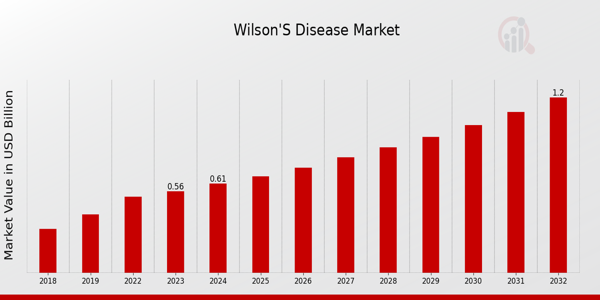Wilson's Disease is a rare genetic disorder characterized by excessive copper accumulation in the body, leading to severe liver and neurological complications. As we move into 2025, the healthcare industry is witnessing significant advancements in the early detection and management of this condition, primarily driven by innovative genetic screening protocols. These changes are not only enhancing patient outcomes but also reshaping the landscape of Wilson's Disease treatment and management.
Wilson's Disease Market growth is projected to reach USD 1.56 Billion, at a 8.82% CAGR by driving industry size, share, top company analysis, segments research, trends, and forecast report 2025 to 2034. This growth is indicative of the increasing awareness and advancements in diagnostic techniques, which are crucial for early intervention and effective management of the disease.

The Importance of Early Detection in Wilson's Disease
Early detection of Wilson's Disease is vital for preventing irreversible damage to the liver and brain. Traditionally, the diagnosis has been challenging due to the variability of symptoms, which can mimic other conditions. However, with the introduction of new genetic screening protocols, healthcare providers can now identify at-risk individuals more effectively.
Genetic testing allows for the identification of mutations in the ATP7B gene, which is responsible for copper transport in the body. By implementing these tests as part of routine screening, especially in populations with a higher prevalence of the disease, healthcare professionals can initiate treatment before significant organ damage occurs. This proactive approach not only improves patient outcomes but also reduces long-term healthcare costs associated with advanced disease management.
Innovations in Genetic Screening Protocols
The advancements in genetic screening protocols for Wilson's Disease are a testament to the ongoing innovation within the healthcare sector. In 2025, we can expect several key changes:
Non-invasive Testing: New technologies are emerging that allow for non-invasive genetic testing, making it easier for patients to undergo screening without the discomfort associated with traditional methods. This is likely to increase participation rates in screening programs.
Integration with Electronic Health Records (EHR): The integration of genetic screening results with EHR systems will enable healthcare providers to track patient data more efficiently, facilitating better management of Wilson's Disease and improving communication among care teams.
Artificial Intelligence (AI) in Diagnostics: AI algorithms are being developed to analyze genetic data and predict the likelihood of Wilson's Disease more accurately. This technology can assist healthcare professionals in making informed decisions regarding patient care.
Regulatory Changes Impacting Wilson's Disease Management
As the healthcare landscape evolves, regulatory bodies are adapting to ensure that new diagnostic tools and treatments are safe and effective. In 2025, we anticipate several regulatory changes that will impact the management of Wilson's Disease:
Streamlined Approval Processes: Regulatory agencies are likely to implement faster approval processes for genetic tests and treatments, allowing patients to access innovative therapies more quickly.
Increased Focus on Patient-Centric Approaches: Regulatory bodies are emphasizing the importance of patient involvement in the development of new treatments and diagnostic tools. This shift is expected to lead to more effective and tailored solutions for individuals with Wilson's Disease.
Enhanced Guidelines for Screening: Updated guidelines for genetic screening will provide healthcare professionals with clear protocols for identifying at-risk populations, ensuring that early detection becomes a standard practice.
Market Trends Shaping the Future of Wilson's Disease Treatment
The market for Wilson's Disease treatment is evolving rapidly, driven by several key trends:
Rising Awareness and Education: Increased awareness among healthcare providers and the public about Wilson's Disease is leading to more individuals seeking testing and treatment. Educational initiatives are crucial in promoting early detection and management.
Investment in Research and Development: Pharmaceutical companies are investing heavily in R&D to develop new therapies that target the underlying causes of Wilson's Disease. This includes gene therapies and novel pharmacological treatments that show promise in clinical trials.
Collaborative Approaches: Partnerships between healthcare providers, research institutions, and pharmaceutical companies are fostering innovation in the field. Collaborative efforts are essential for advancing the understanding of Wilson's Disease and improving treatment options.
Clinical Applications of New Genetic Screening Protocols
The clinical applications of the new genetic screening protocols for Wilson's Disease are vast and impactful:
Personalized Treatment Plans: With accurate genetic information, healthcare providers can develop personalized treatment plans that address the specific needs of each patient, improving overall outcomes.
Monitoring Disease Progression: Genetic screening can help monitor disease progression and treatment efficacy, allowing for timely adjustments to therapy as needed.
Family Screening: Identifying a patient with Wilson's Disease can prompt screening for family members, facilitating early detection and intervention for at-risk individuals.
Conclusion
As we look ahead to 2025, the advancements in genetic screening protocols for Wilson's Disease are set to revolutionize early detection and management. With a focus on innovation, sustainability, and regulatory changes, the healthcare industry is poised to improve patient outcomes significantly. By embracing these changes, medical professionals, procurement managers, hospital administrators, manufacturers, and regulatory bodies can work together to create a future where Wilson's Disease is detected early and managed effectively, ultimately enhancing the quality of life for those affected.








